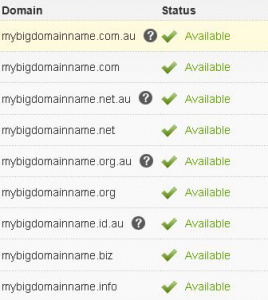What is an URL and how is it different to a domain name? In this interview Reece Lamshed asks John Parnell Pierce to explain the difference between domains and URLs.
Note: This interview is 6 years old. It was part of a training resource for beginner interactive media students. Though web technology has changed, the principles discussed are still relevant.
Transcript
REECE: Just a brief thing about URLs, I suppose what they are, I mean we know the address of where someone goes to find the website, and perhaps, the difference between that and domain name?
JOHN: Look we actually have to break this down a bit further because you got the domain names, you have a host name, and you have a URL. Now, a domain name is a name that has been registered by someone to identify the computers within the network. Like for example, Telstra. Telstra goes and registers Telstra.com.au and that is the domain name. Telstra can then use that to describe all the computers done within this network. So the Telstra website, it’s going to be www.telstra.com.au, that’s the host name for the website. However, they also have name servers and they going to be called things like dns1.telstra.com.au. So that computer, which is the name server, has a different host name, dns1, whatever. They could have a search engine, they might call search.telstra.com.au and that again is a host name for third computer.
The URL goes a step further. The URL is used to identify a given resource located on a computer with a given host name. So if I’m looking for a homepage on Telstra’s website it’s gonna be the host name slash whatever the name with that file is. Convention is to put an http:// at the front of it, that tells the web browser that the page you are accessing is a hypertext page and HTML page. The HTTP stands for hypertext transfer protocol, so the cue to the browser of what the sort of page is it that your loading. If it was an FTP page, and that is another way of sending information, it would have ftp://. If it was an email server why have smtp:// and so on. There are always different standards for identifying the type of server that you are getting information off.
And back to the URL. The URL therefore split ups in to several parts. The first part is the protocol that you are using the http://. You then have the host name. The first part of the host name is the www and that defines the computer that you are on. The second part, which is the rest of the domain name, defines the network that that computer is part of, after that you have a slash. That slash represents the root directory of the computer that the host name points to.
REECE: Yup.
JOHN: Then you can have a file which would be a webpage, it could be an index.htm, could be an index.html, it could be default.htm, could be a .php, and could be a .asp. There’s quite a range of different file types that you can sit there, but the first one there is usually going to be the homepage. You can have folders within there, so you might have all your images in a separate folder. So then you would have your whole Protocol, Host name, Domain name, slash, then the folder, or it could be images slash name of the file of the image. So if it is a picture of the dog, it’s going to be dog.gif.
REECE: And with the .com, .org, or .business as they are now, what is that indicating?
JOHN: The .com, .org, or .biz or even the .com.au’s are basically different domain names types which have been set up to reflect different types of / styles of websites, actually different styles of domains and also different nationality. So all country have the 2-letter code at the end, so Australia has .au, United States has .us, United Kingdom has .uk and so on. This is the standard 2-letter code, there’s actually an international standard for this codes and each country own code is used. Dot com by convention is used for commercial entities, so for business names and individuals can also get a .com if you like. Within Australia to get a .com.au you actually have to demonstrate that you own that name. So my business is called Internet Guru, I had to prove that I actually own the business name Internet Guru before I can get internetguru.au. Other ones, .org is usually used for organizations and non-profit groups within Australia. We also have asn which stands for association that is use for clubs and societies. Trade unions sometimes use asn. There’s gov which is reserved purely for government organization, edu, purely reserved for educational, and then we start getting some stranger ones like id. “id” can be used for individuals basically.
I can get JohnPierce.id if it’s available, there’s .info which is for information resources, libraries for example. Dot biz is purely a business category. Biz itself is seen as being a fairly a low rent category, it’s one that is often associated with some darker side of business like pills and the dodgier retailers. That given though, they have some decent businesses using .biz also, but it has been a case that those after a quick buck have tended to jump on that category as one to use.

